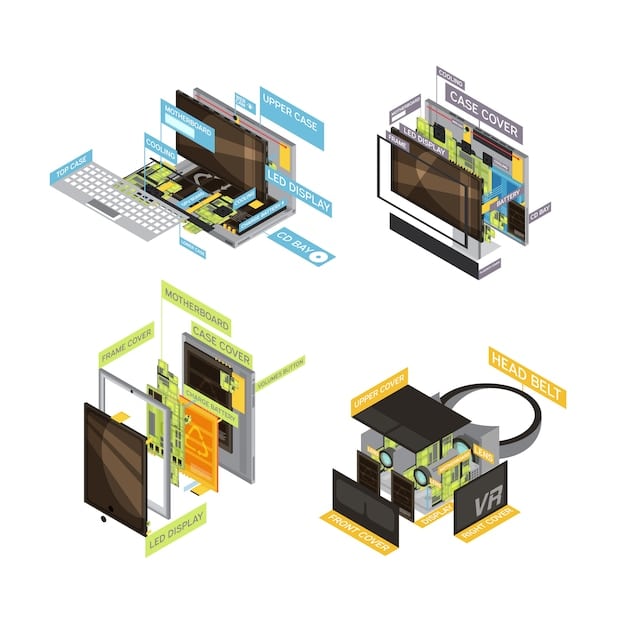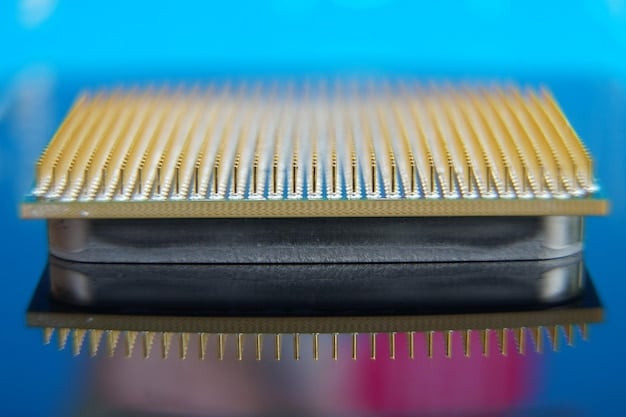VR Ready PCs: Preparing for Immersive Gaming in 2025

VR Ready PCs: Meeting the Minimum and Recommended Specs for Immersive Gaming in 2025 requires understanding the necessary hardware, including processors, graphics cards, RAM, and storage, to ensure a smooth and immersive virtual reality experience in the coming years.
Are you ready to dive into the immersive world of virtual reality gaming in 2025? Ensuring you have a VR Ready PC: Meeting the Minimum and Recommended Specs for Immersive Gaming in 2025 is crucial for a seamless and enjoyable experience.
Understanding the VR Gaming Landscape in 2025
As we approach 2025, the virtual reality gaming landscape continues to evolve, demanding more from our hardware. Understanding the current trends and future requirements is essential for building or upgrading a VR ready PC.
The Evolution of VR Technology
VR technology has advanced significantly in recent years, offering more immersive experiences. To keep up with these advancements, your PC needs to meet certain specifications.
Newer VR headsets boast higher resolutions, refresh rates, and more complex environmental interactions, all of which place greater demands on your PC’s components.
Key Trends Shaping VR Gaming in 2025
Several trends are shaping the future of VR gaming, including:
- Enhanced graphics and realistic simulations.
- Wider adoption of wireless VR headsets.
- Integration of haptic feedback and motion tracking technologies.
These trends highlight the need for powerful PCs capable of handling complex VR environments and interactions.
Keeping an eye on these trends will ensure that your PC is well-suited for the VR experiences of tomorrow.

In conclusion, staying informed about the evolving VR landscape is vital for ensuring your PC remains capable of delivering high-quality VR experiences. Monitoring these trends and understanding their hardware implications will enable you to make informed decisions about your system’s capabilities.
Minimum vs. Recommended Specs: What’s the Difference?
When it comes to VR ready PCs, understanding the difference between minimum and recommended specifications is crucial. Meeting the minimum requirements will allow you to run VR games, but the recommended specs ensure a smooth and immersive experience.
The minimum specifications represent the bare minimum hardware needed to run a VR application, often resulting in lower graphical settings and potential performance issues.
Breaking Down the Minimum Specs
The minimum specifications typically include:
- CPU: Intel Core i5-4590 or AMD FX 8350
- GPU: NVIDIA GeForce GTX 970 or AMD Radeon R9 290
- RAM: 8GB
While these specs may allow you to run VR games, the experience might be far from optimal, with noticeable lag and reduced visual fidelity.
Aiming for the Recommended Specs
The recommended specifications provide a much better VR experience, with higher graphical settings and smoother performance.
These specs include:
- CPU: Intel Core i5-7600K or AMD Ryzen 5 1600
- GPU: NVIDIA GeForce GTX 1060 or AMD Radeon RX 480
- RAM: 16GB
Investing in hardware that meets the recommended specifications will significantly enhance your VR gaming experience, providing more immersive and enjoyable gameplay.
In summary, the difference between minimum and recommended specifications is substantial. While minimum specs may get you into the VR world, the recommended specs ensure a much smoother and visually impressive journey.
The Heart of Your VR PC: CPU Requirements
The CPU, or central processing unit, is a critical component for a VR ready PC. It handles the complex calculations and processing required for VR applications, affecting overall performance and responsiveness.
A powerful CPU ensures that your VR games run smoothly, without lag or stuttering, even when dealing with complex environments and interactions.
Minimum CPU Requirements for VR in 2025
For a basic VR experience in 2025, aim for at least an Intel Core i5-9400F or an AMD Ryzen 5 3600.
These CPUs offer a good balance of performance and affordability, capable of handling many VR applications at lower settings.
Recommended CPU for Immersive VR Gaming
For a truly immersive VR gaming experience, consider CPUs like the Intel Core i7-10700K or the AMD Ryzen 7 3700X.
These CPUs provide ample processing power to handle demanding VR games, ensuring smooth and responsive gameplay even at higher graphical settings.

The CPU is a key component of any VR Ready PCs: Meeting the Minimum and Recommended Specs for Immersive Gaming in 2025. Choose one that matches your needs.
In conclusion, the CPU is a crucial component for a VR ready PC, affecting overall performance and responsiveness. Selecting a CPU that meets or exceeds the recommended specifications will ensure a smooth and immersive VR gaming experience in 2025.
Graphics Power: GPU Considerations for VR
The GPU, or graphics processing unit, is arguably the most important component for a VR ready PC. It’s responsible for rendering the visuals and creating the immersive environments that define the VR experience.
A powerful GPU ensures that your VR games look stunning and run smoothly, without compromising on visual fidelity or performance.
Minimum GPU Requirements for VR Gaming
To meet the minimum GPU requirements for VR gaming in 2025, consider options like the NVIDIA GeForce GTX 1660 Super or the AMD Radeon RX 5500 XT.
These GPUs provide enough graphical horsepower to run many VR applications at lower settings, though you might need to compromise on visual quality.
Stepping Up to Recommended GPUs
For a truly immersive VR experience, aim for GPUs like the NVIDIA GeForce RTX 3060 or the AMD Radeon RX 6600 XT.
- These GPUs offer significantly better performance, allowing you to enjoy VR games at higher resolutions and graphical settings.
- Ensuring smooth and responsive gameplay.
Investing in a high-end GPU is essential for a seamless and visually stunning VR gaming experience, allowing you to fully appreciate the immersive worlds that VR has to offer.
In conclusion, the GPU is a critical component for a VR ready PC, responsible for rendering the visuals and creating immersive environments. Choosing a GPU that meets or exceeds the recommended specifications will ensure a smooth, visually impressive and engaging VR experience in 2025.
Ensuring Smooth Performance: RAM and Storage
While the CPU and GPU are critical, RAM and storage also play a significant role in ensuring smooth performance for VR ready PCs. Adequate RAM ensures that your system can handle multiple tasks simultaneously, while fast storage reduces loading times and improves overall responsiveness.
Insufficient RAM or slow storage can lead to stuttering, lag, and long loading times, detracting from the immersive VR experience.
The Importance of RAM for VR Gaming
For VR gaming in 2025, 16GB of RAM is generally considered the sweet spot. This amount of RAM allows your system to handle the demands of VR applications without running into performance issues.
While 8GB might be sufficient for some VR games, 16GB provides a more comfortable and reliable experience, especially when multitasking or running other applications in the background.
Storage Solutions: SSD vs. HDD
When it comes to storage, solid-state drives (SSDs) are highly recommended for VR ready PCs.
- SSDs offer significantly faster read and write speeds compared to traditional hard disk drives (HDDs), resulting in quicker loading times and improved overall system responsiveness.
- Consider using an NVMe SSD for your operating system and VR games for the best possible performance.
While HDDs can be used for storing less frequently accessed files, an SSD is essential for ensuring a smooth and responsive VR gaming experience.
In summary, RAM and storage are crucial components for a VR ready PC, ensuring smooth performance and quick loading times. Investing in 16GB of RAM and an SSD will significantly enhance your VR gaming experience in 2025.
Connectivity and Compatibility: Headsets and Ports
Connectivity and compatibility are essential considerations for VR ready PCs. Ensuring that your system has the necessary ports and is compatible with your VR headset is crucial for a seamless and enjoyable experience.
Incompatible ports or outdated connectivity standards can lead to performance issues and prevent you from fully utilizing your VR headset’s capabilities.
Essential Ports for VR Headsets
Most VR headsets require specific ports to connect to your PC:
- HDMI: Used to transmit video signals from your GPU to the headset.
- USB: Used for data transfer and tracking information.
Ensure that your PC has enough of these ports to accommodate your VR headset’s requirements. USB 3.0 or higher ports are recommended for faster data transfer speeds.
Wireless VR and Bluetooth Connectivity
As wireless VR headsets become more popular, Bluetooth connectivity is also becoming increasingly important.
Bluetooth is used for connecting controllers and other accessories to your VR headset, providing a more immersive and untethered experience.
Ensuring that your PC has Bluetooth 5.0 or higher will ensure a stable and reliable connection with your wireless VR peripherals.
In conclusion, connectivity and compatibility are vital considerations for VR ready PCs, ensuring a seamless and enjoyable VR experience. Verifying that your system has the necessary ports and connectivity standards will allow you to fully utilize your VR headset’s capabilities in 2025.
| Key Point | Brief Description |
|---|---|
| 💡 CPU Choice | Select a CPU like Intel i7 or AMD Ryzen 7 for optimal VR. |
| 🚀 GPU Power | Aim for NVIDIA RTX 3060 or AMD RX 6600 XT for smooth visuals. |
| 💾 RAM & Storage | Have 16GB RAM and use SSD for faster loading. |
| 🔗 Connectivity | Ensure HDMI and USB 3.0 ports for headset compatibility. |
Frequently Asked Questions
▼
The minimum CPU specs include Intel Core i5-9400F or AMD Ryzen 5 3600. These CPUs provide a basic VR experience, though graphical settings may need to be adjusted.
▼
16GB of RAM is generally recommended for VR gaming in 2025. This amount ensures smooth performance, especially when multitasking or running other applications.
▼
SSDs offer faster read and write speeds compared to HDDs. This results in quicker loading times and improved system responsiveness, enhancing the VR experience.
▼
For an immersive VR experience, aim for GPUs like the NVIDIA GeForce RTX 3060 or the AMD Radeon RX 6600 XT. These provide high-quality visuals and smooth performance.
▼
Essential ports include HDMI for video and USB 3.0 for data transfer. Some wireless headsets may also require Bluetooth 5.0 or higher for connecting peripherals.
Conclusion
In conclusion, building a VR Ready PCs: Meeting the Minimum and Recommended Specs for Immersive Gaming in 2025 requires careful consideration of each component, from the CPU and GPU to RAM and storage. By understanding the minimum and recommended specifications, you can ensure a seamless and immersive VR gaming experience in the years to come.





